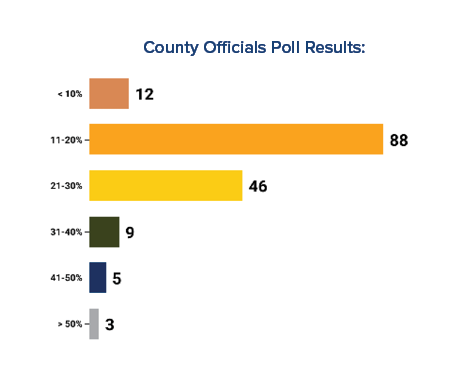Seven Ways Assessors Can Communicate About Rapidly-Rising Housing Prices
Minimize Distress, Misunderstanding, and Appeals - Build Trust with Clear and Proactive Communication
When homeowners worry about the impact that today’s record-setting property values will have on their tax bills, they often turn to their local assessing office with questions and complaints.
Assessors can minimize distress, misunderstanding, and appeals — and build trust — with clear and proactive communications.
Vision Government Solutions explored this issue in our recent webinar, Addressing Homeowners Alarm Over Rising Values, which was moderated by IAAO Past President Bruce Woodzell.
Our Panelists:

Jessica Lautz
National Association of Realtors

Joshua Zeyn
Chief Assessor
Tioga County, PA

Gus Martinez
County Assessor
Sante Fe County, NM
Bruce Woodzell
Moderator & IAAO Past President
During the session, Jessica Lautz of the National Association of Realtors (NAR) described today’s unprecedented housing market — record-setting year-over-year (YoY) price increases, historically low housing inventories, and rapid sales with buyers routinely paying full asking price or more.
This trend is affecting the entire country. NAR data shows that YoY price increases have occurred in 99% of the 180-plus metropolitan statistical areas they track. “That in itself is extraordinary,” Lautz said. “This is not an environment we’ve seen in the past, when [rapidly-rising home prices typically were limited] to select coastal regions. It really is happening in every market. In more than 75% of markets, we’re seeing double-digit year-over-year increases.”
County officials who attended the webinar were asked how property values have changed in their communities in the past year — and their responses were consistent with national trends.
This trend is impacting most assessing officials, including two of the webinar’s panelists — Joshua Zeyn, Chief Assessor for Tioga County in north-central Pennsylvania, and Gus Martinez, County Assessor for Santa Fe County, New Mexico. They shared a number of their best practices for communicating with constituents in this dynamic environment.

“This is not an environment we’ve seen in the past, when [rapidly rising home prices typically were limited] to select coastal regions. It really is happening in every market.”
– Jessica Lautz, National Association of Realtors
The Seven Steps:
1. Have a Communications Plan for Your Reassessment
Early this year, Tioga County authorized its first property reassessment in two decades, prompting the Assessor’s Office to develop a three-part communication plan with specific goals:
- In the start-up phase, explain the goals of the reassessment (principally to reestablish uniformity and equity in property values).
- During the field review & data collection phase, explain when and why data collectors will be in communities so property owners know what to expect and are better prepared to cooperate.
- Communicate new property values and how to interpret them accurately.
With each communication initiative, articulate key objectives and then determine the messages, tactics, timing, and communication channels needed to accomplish them.
2. Segment Your Audience
Zeyn and his team identified important groups in the community to engage through their communications strategy — property owners, local officials, civic and professional organizations, the news media, developers, and real estate appraisers and brokers. Their first step was to inform and solicit input from the local board of realtors and, soon after, all of the county’s real estate professionals. “For this to be a successful project we had to have them on board,” Zeyn said.
3. Be Proactive
The Tioga County Assessor’s Office issued a press release to inform the community ahead of the vote by the County Commissioners on whether to proceed with the proposed reassessment. The detailed, 4-page announcement provided background information, data, and the rationale for the project. Once the project was underway, they informed neighborhoods when data collectors would be in the area and what information they were seeking.
4. Be Accessible
In Santa Fe County, Martinez’s team uses several tactics to inform the community on an ongoing basis. As a result, property valuation appeals have declined 90% — from 11,000 a year to about 1,100.
The Santa Fe County Assessor’s Office conducts outreach events around the county each April to answer questions after Notices of Value are distributed. They use social media to share information and updates from the office, local housing market trends, and who’s responsible for setting and imposing property tax rates (the state Department of Finance and Administration and the Santa Fe County Commissioners, respectively).
“We want to connect with the public and… get our message out,” Martinez said.
5. Direct Residents to a Single Source of Truth
Both Tioga and Santa Fe County assessors aggressively maintain their websites, providing detailed information about property values, assessment processes, tax rates, and more. They direct residents to these resources through their assorted communication channels — press releases and media interviews, direct mail, social media, public events, door hangers, and brochures. The Santa Fe County site generates 60,000 hits a month.
6. Be Clear, Transparent—and Share the Technical Details
Zeyn said his team built their communications strategy based on the following IAAO public relations standards:
- Provide clear, simple communications that avoid jargon and acronyms.
- Anticipate and prepare for negative feedback. (The Tioga Assessor’s Office does not routinely use social media, but it has a plan to do so if residents raise concerns on Facebook or other social platforms).
- Be transparent and provide accurate, up-to-date data.
It’s important to share technical information, Zeyn advised, for residents who want to dig into the details.
7. Empower the Public
During community events organized by the Santa Fe County Assessor’s Office, the staff teach residents how to submit appeals. In Tioga County, residents are sent the information compiled by data collectors so they can review and correct it before valuations are set. “As you accommodate the constituent, it builds trust,” Martinez said. “As you’re pushing the message and telling the story, it builds trust in the community,” he noted. “The more information you put out there to the public… the more they’ll understand why values are rising.”
Want more of Vision’s beloved web series? Follow along during our regularly scheduled webinars, and watch recordings of past sessions.
Join us as we explore the impact new and emerging digital technology has on the way we work and what it means for the future of professionals in the assessing industry.


